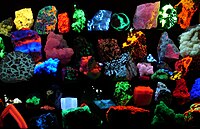
Photo from wikipedia
Abstract The coral Li/Mg temperature proxy is revisited through an in-depth trace element analysis of scleractinians collected live from tropical to polar environments. The dataset consists of Li/Ca, Mg/Ca, Sr/Ca… Click to show full abstract
Abstract The coral Li/Mg temperature proxy is revisited through an in-depth trace element analysis of scleractinians collected live from tropical to polar environments. The dataset consists of Li/Ca, Mg/Ca, Sr/Ca and Li/Mg ratios from 64 coral specimens belonging to 8 different taxa, including both reef-building zooxanthellate and cold-water non-zooxanthellate species, from a wide range of water temperature (−1 to 29.5 °C), salinity (34.71 to 38.61), and depth (3 to 670 m). Our results showed that the reliability of the Li/Mg temperature proxy is strongly limited by the organic matter associated with the coral skeleton, which is most evident within the green bands observed in tropical corals. Organic-rich bands can double the Mg content otherwise present in the skeleton, which may ultimately lead to a temperature overestimation exceeding 15 °C. We found that this bias can be overcome by the treatment of coral skeletons with a specific oxidizing cleaning protocol. We also detected the presence of calcite deposits within the aragonite skeleton of some Antarctic living coral specimens, which strongly affects the robustness of the Li/Mg proxy given its temperature sensitivity of ~1.5 °C/1% calcite. Therefore, to obtain reliable reconstructions a correction needs to be applied when organic matter and/or calcite contamination is present, which requires the scrupulous assessment of the integrity of the aragonite prior to geochemical analyses. Given that some species entrap more organic matter than others, and that some are more prone to calcite contamination, a taxon-related effect is apparent. Here we show that the tropical species Porites spp., Pseudodiploria strigosa and Orbicella annularis, and the cold-water species Madrepora oculata, Caryophyllia antarctica and Flabellum impensum, are all suitable candidates for reconstructing seawater temperatures. The integrated results across a wide temperature range, from extreme cold to tropical shallow waters, yield an overall precision for the Li/Mg-temperature proxy of ±1.0 °C, as quantified by the standard error of estimates. If calculated from the 95% prediction intervals, the uncertainty of the temperature estimates is ±0.9 °C at 1 °C, ±1.5 °C at 12 °C and ± 2.6 °C at 25 °C. However, the uncertainty for the tropical corals (e.g. Porites) can be reduced to ±0.6 °C if a Li/Mg and Sr/Ca multi-regression approach is applied.
Journal Title: Chemical Geology
Year Published: 2019
Link to full text (if available)
Share on Social Media: Sign Up to like & get
recommendations!